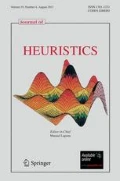Abstract
We consider a robotized analytical system in which a chemical treatment has to be performed on a given set of identical samples. The objective is to carry out the chemical treatment on the whole set of samples in the shortest possible time. All constraints have to be satisfied since a modification of the chemical process could create unexpected reactions.
We have developed a new robust method governed by a genetic algorithm to solve this scheduling problem. The crossover mechanism of this evolutionary method is based on an extension of the uniform crossover introduced by Syswerda (1989).
The proposed approach can be adapted to other combinatorial problems where decisions, based on rules, have to be taken at each step of a constructive method.
Similar content being viewed by others
References
Barnes, J.W. and M. Laguna. (1993). “A Tabu Search Experience in Production Scheduling,” Annals of Operations Research 41, 141-156.
Booker, L.B. (1982). “Intelligent Behavior as an Adaptation to the Task Environment,” Doctoral Dissertation, Technical Report No. 243, Ann Arbor, University of Michigan, Etats-Unis.
Brindle, A. (1981). “Genetic Algorithms for Function Optimization.” Unpublished Doctoral Dissertation, University of Alberta, Canada.
Dell'Amico, M. and M. Trubian. (1993). “Applying Tabu Search to the Job Shop Scheduling Problem,” Annals of Operations Research 41, 231-252.
Dorndorf, U. and E. Pesch. (1995). “Evolution Based Learning in Job Shop Scheduling Environment,” Computers and Operations Research 22(1), 25-40.
Fisher, H. and G.L. Thompson. (1963). “Probabilistic Learning Combinations of Local Job Shop Scheduling Rules.” In J.F. Muth and G.L. Thompson (eds.), Industrial Scheduling. Englewood Cliffs: Prentice Hall.
Fleurent, C. (1994). “Algorithmes Génétiques Hybrides pour l'Optimisation Combinatoire,” Thèse présentée au Départment d'Informatique et de Recherche Opérationnelle, Université de Montréal, Canada.
Glover, F. (1994). “Tabu Search for Nonlinear and Parametric Optimization (with Links to Genetic Algorithms),” Discrete Applied Mathematics 49, 231-255.
Goldberg, D.E. (1989). Genetic Algorithms in Search, Optimization and Machine Learning. Addison Wesley.
Hall, N.G., H. Kamoun, and C. Sriskandarajah. (1993a). “Scheduling in Robotic Cells: Two Machine Cells and Identical Parts.” Report 93-06, Department of Industrial Engineering, University of Toronto, Canada. To appear in Operations Research.
Hall, N.G., H. Kamoun, and C. Sriskandarajah. (1993b). “Scheduling in Robotic Cells: Large Cells.” Report 93-07, Department of Industrial Engineering, University of Toronto, Canada.
Hall, N.G. and C. Sriskandarajah. (1993). “Machine Scheduling Problems with Blocking and No-Wait in Process.” Report 91-05 (revised in February 1993), Department of Industrial Engineering, University of Toronto, Canada.
Hertz, A., Y. Mottet, and Y. Rochat. (1996). “On a Scheduling Problem in a Robotized Analytical System,” Discrete Applied Mathematics 65, 285-318.
Holland, J.H. (1975). Adaptation in Natural and Artificial Systems. Ann Arbor: University of Michigan Press.
Ioachim, I. and F. Soumis. (1993). “Schedule Efficiency in a Robotic Production Cell.” Cahier du GERADG-93-05, École des HEC, Montréal, Canada.
Laarhoven, P.J.M., E.H. Aarts, and J.K. Lenstra. (1992). “Job Shop Scheduling by Simulated Annealing,” Operations Research 40, 113-125.
O'Grady, P.J. and C. Harrison. (1985). “A General Search Sequencing Rule for Job Shop Sequencing,” Int. J. Prod. Res. 23, 951-973.
Raff, S.J. (ed.). (1995). Computers and Operations Research 22.Special Issue on Genetic Algorithms, No. 1.
Sethi, S.P., C. Sriskandarajah, G. Sorger, J. Blazewicz, and W. Kubiak. (1992). “Sequencing of Parts and Robot Moves in a Robotic Cell,” The International Journal of Flexible Manufacturing Systems 4, 331-358.
Syswerda, G. (1989). “Uniform Crossover in Genetic Algorithms.” In J.D. Schaffer (ed.), Proc. Third International Conf. on Genetic Algorithms. Morgan Kaufman Publishers, pp. 2-9.
Widmer, M. and A. Hertz. (1989). “A New Heuristic Method for the Flow Shop Sequencing Problem,” European Journal of Operational Research 41, 186-193.
Author information
Authors and Affiliations
Rights and permissions
About this article
Cite this article
Rochat, Y. A Genetic Approach for Solving a Scheduling Problem in a Robotized Analytical System. Journal of Heuristics 4, 245–261 (1998). https://doi.org/10.1023/A:1009613700772
Issue Date:
DOI: https://doi.org/10.1023/A:1009613700772




